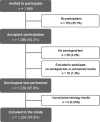COVID-19 among workers of a comprehensive cancer centre between first and second epidemic waves (2020): a seroprevalence study in Catalonia, Spain
- PMID: 35450905
- PMCID: PMC9023852
- DOI: 10.1136/bmjopen-2021-056637
COVID-19 among workers of a comprehensive cancer centre between first and second epidemic waves (2020): a seroprevalence study in Catalonia, Spain
Abstract
Objectives: Patients with cancer are at higher risk for severe COVID-19 infection. COVID-19 surveillance of workers in oncological centres is crucial to assess infection burden and prevent transmission. We estimate the SARS-CoV-2 seroprevalence among healthcare workers (HCWs) of a comprehensive cancer centre in Catalonia, Spain, and analyse its association with sociodemographic characteristics, exposure factors and behaviours.
Design: Cross-sectional study (21 May 2020-26 June 2020).
Setting: A comprehensive cancer centre (Institut Català d'Oncologia) in Catalonia, Spain.
Participants: All HCWs (N=1969) were invited to complete an online self-administered epidemiological survey and provide a blood sample for SARS-CoV-2 antibodies detection.
Primary outcome measure: Prevalence (%) and 95% CIs of seropositivity together with adjusted prevalence ratios (aPR) and 95% CI were estimated.
Results: A total of 1266 HCWs filled the survey (participation rate: 64.0%) and 1238 underwent serological testing (97.8%). The median age was 43.7 years (p25-p75: 34.8-51.0 years), 76.0% were female, 52.0% were nursing or medical staff and 79.0% worked on-site during the pandemic period. SARS-CoV-2 seroprevalence was 8.9% (95% CI 7.44% to 10.63%), with no differences by age and sex. No significant differences in terms of seroprevalence were observed between onsite workers and teleworkers. Seropositivity was associated with living with a person with COVID-19 (aPR 3.86, 95% CI 2.49 to 5.98). Among on-site workers, seropositive participants were twofold more likely to be nursing or medical staff. Nursing and medical staff working in a COVID-19 area showed a higher seroprevalence than other staff (aPR 2.45, 95% CI 1.08 to 5.52).
Conclusions: At the end of the first wave of the pandemic in Spain, SARS-CoV-2 seroprevalence among Institut Català d'Oncologia HCW was lower than the reported in other Spanish hospitals. The main risk factors were sharing household with infected people and contact with COVID-19 patients and colleagues. Strengthening preventive measures and health education among HCW is fundamental.
Keywords: COVID-19; SARS-CoV-2; antibody; epidemiology; health care workers; seroprevalence.
© Author(s) (or their employer(s)) 2022. Re-use permitted under CC BY. Published by BMJ.
Conflict of interest statement
Competing interests: JJ received research funding from Kyowa Kirin and from Angelini Pharma for congress attendance. The Cancer Epidemiology Research Programme has received grants from Merck & Co., Roche, GSK, IDT, Hologic and Seegene.
Figures
References
-
- Informe n° 56 . Situación de COVID-19 en España. Casos diagnosticados a partir de 10 de Mayo. Instituto de Salud Carlos III; red Nacional de Vigilancia Epidemiológica. España, 2020. Available: https://www.isciii.es/QueHacemos/Servicios/VigilanciaSaludPublicaRENAVE/...
-
- Centro de Coordinación de Alertas y, Emergencias Sanitarias . Actualización no 517. Enfermedad por el coronavirus (COVID-19). 03.12.2021 [Internet]. Available: https://www.sanidad.gob.es/profesionales/saludPublica/ccayes/alertasActu... [Accessed 01 Feb 2022].
-
- Dai M, Liu D, Liu M, et al. . Patients with cancer appear more vulnerable to SARS-CoV-2: a multicenter study during the COVID-19 outbreak. Cancer Discov 2020;10:783. 10.1158/2159-8290.CD-20-0422 - DOI - PMC - PubMed
Publication types
MeSH terms
Substances
LinkOut - more resources
Full Text Sources
Medical
Research Materials
Miscellaneous

